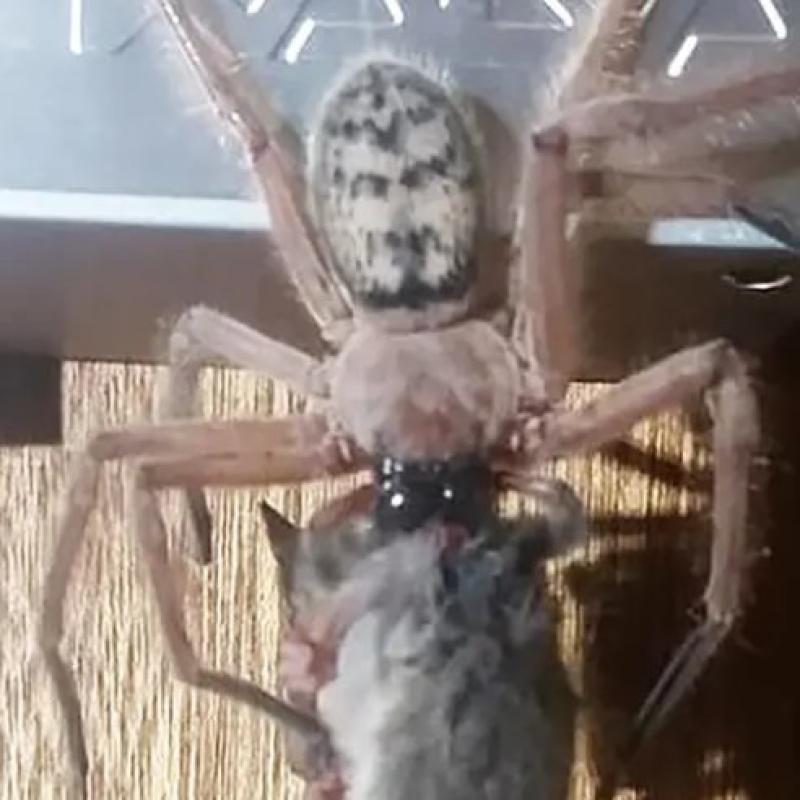Odds 'n ends - June 18th, 2019



Pygmy possums usually aren’t on the menu for huntsman spiders.
But an Australian man from Tasmania has captured the rare moment a huntsman attempted to devour a tiny possum at a lodge in the Mount Field national park, 64 km north-west of Hobart.
Justine Latton posted the photo her husband took, on a Facebook group devoted to Tasmanian spiders and insects.
Australia Museum arachnology collection manager Graham Milledge said it was an unusual event.
“It would be fairly rare,” he told the Guardian. “It’s the first time I’ve seen a pygmy possum as prey.” He said it was more common to see huntsman eat small birds, frogs and geckos.
Tasmania is home to two types of pygmy possums – the little pygmy and the eastern pygmy.
The eastern pygmy can grow to between 15 grams and 43 grams in weight – which is less than a golf ball , with a body length of 7-11 centimetres.
Read the rest of the article in The Guardian
Burkina Faso: Travel advisory maps comparison.

Daring maneuver brings NASA’s orbiter closer to an asteroid than ever before

A recent tweak to its orbit has brought the probe to an orbit of just 680 meters, or around 2,230 feet from the asteroid’s surface. This is now the closest that any manmade spacecraft has orbited any planetary body.
It’s a stellar achievement for NASA, but it’s worth noting that the previous record was actually already held by the OSIRIS-REx probe. What NASA did was break its own record and set itself even farther ahead from any competition to come in the future.
This new orbit, which the research team calls the Orbital B phase, will give scientists a better understanding of the asteroid’s surface and hopefully allow NASA to choose a suitable location where the probe can briefly snag a sample of its material.
Actually pulling off such a daring maneuver will be incredibly risky, and nobody is quite sure if the spacecraft can make it happen. This is due in large part to the incredibly messy surface of Bennu, which surprised scientists when they got their first close look. The asteroid’s surface is littered with debris ranging from tiny pebbles to massive boulders, and the spacecraft’s handlers now have to find the safest place on the rock from which to gather a sample.
Assuming it pulls off the sample grab, the probe will then leave Bennu and return to Earth with the sample material stowed safely for scientists on Earth to examine.
Distribution of the Great Apes

Spectacular New Crater Discovered on Mars

A fresh Martian crater has been detected in a stunning new image taken by NASA’s Mars Reconnaissance Orbiter.
Using its High-Resolution Imaging Science Experiment (HiRISE), the spacecraft photographed the new feature on April 17, 2019 from an altitude of 255 kilometers (158 miles), according to a HiRise press release. The crater is located in the Valles Marineris region near the equator, and it formed at some point between September 2016 and February 2019. We can’t yet monitor the entire Martian surface at shorter intervals, hence the uncertainty as to when it formed.
The HiRise release described the new photo as a “work of art,” saying “the darker material exposed beneath the reddish dust” is what makes this particular crater stand out. The bluish areas in the false-color image above show areas in which the red surface material was most disrupted by the impact.



It takes a bit of time to prepare this page - lots of formatting, links, and so on.
So... if no one cares... This is the last.
LOL sorry Bob, my sympathies will ever lie with the mammals (I used to be one) marsupials and birds over spiders and reptiles. Yep, every time.
I liked NASA and the asteroid, but that looks like a hard asteroid and I really wonder about snagging a piece off it. I'm thinking we're going to be hearing about a crash or a miss soon.
I don't have any wild links, but I've got this here pic. Sometime when someone is bored and has a small sharp knife and a marking pencil....
I like spiders; but I don't think my first reaction to seeing one that large would be, "I need to take pictures, and get a video to post on this!"
It looks like the picture was taken indoors? I know it is a lodge; but isn't the wildlife supposed to be on the outside?
Interesting stuff.
That said, i have to admit.
I didn't have the slightest idea of where Burkina Faso was in Africa.